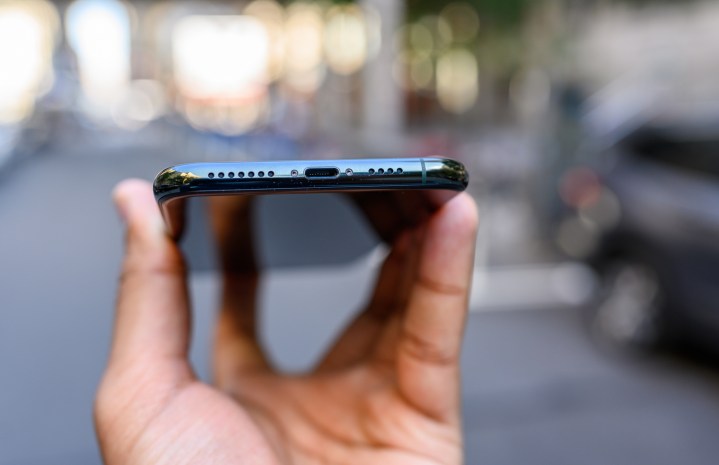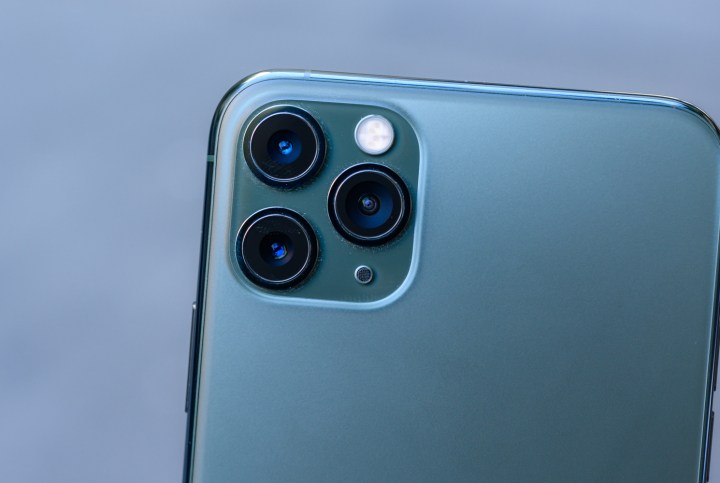The Motorola Edge Plus and the iPhone 11 Pro Max are big flagship smartphones. Weighing over 200 grams and boasting screens in excess of 6.4 inches, both mobiles dwarf the competition. They each pack state-of-the-art processors, triple-lens camera systems, and juicy batteries into their larger-than-average frames, making them two of the highest-performing smartphones around. Regardless of which one you choose, it would be very unlikely you’d come away disappointed.
For those of us who don’t have the luxury of buying two phones at once, this article pits the Motorola Edge Plus against the iPhone 11 Pro Max. It compares the two smartphones across six categories, looking at their designs, performances, cameras, software, special features, and price. By explaining which smartphone comes out on top in each of these areas, it should help you decide which is the smartphone for you.
Specs
| Motorola Edge Plus | iPhone 11 Pro Max | |
| Size | 161.1 x 71.4 x 9.6mm (6.34 x 2.81 x 0.38 inches) | 158 x 77.8 x 8.1 mm (6.22 x 3.06 x 0.32 inches) |
| Weight | 203 grams (7.16 ounces) | 226 grams (7.97 ounces) |
| Screen size | 6.7-inch OLED | 6.5-inch Super Retina XDR OLED |
| Screen resolution | 2,340 x 1,080 pixels, 19.5:9 ratio (385 pixels-per-inch) | 2,688 x 1,242 pixels (458 pixels-per-inch) |
| Operating system | Android 10 | iOS 13 |
| Storage | 256GB | 64GB, 256GB, 512GB |
| MicroSD card slot | Yes | No |
| Tap-to-pay services | Google Pay | Apple Pay |
| Processor | Qualcomm Snapdragon 865 | Apple A13 Bionic chip |
| RAM | 12GB | 4GB |
| Camera | 108MP, 8MP telephoto, and 16MP ultrawide, time-of-flight 3D rear, 25MP front | Triple lens 12MP wide, 12MP ultrawide, and 12MP telephoto rear; 12MP TrueDepth front |
| Video | 6K at 30fps, 4K at 30fps, 1080p at 120fps | 4K at up to 60 fps, 1080p at 240 fps |
| Bluetooth version | 5.1 | 5.0 |
| Ports | USB 3.1 (USB C) | Lightning |
| Fingerprint sensor | Yes, in-display | No, Face ID instead |
| Water resistance | No official rating | IP68 |
| Battery | 5,000mAh
Fast charging (18W) Fast wireless charging (15W) |
3,969mAh
Fast charging (18W) Qi wireless charging |
| App marketplace | Google Play Store | Apple App Store |
| Network support | Verizon | AT&T, T-Mobile, Sprint, Verizon |
| Colors | Smokey Sangria, Thunder Grey | Midnight Green, Space Gray, Silver, Gold |
| Prices | $1,000 | $1,100 |
| Buy from | Verizon | Apple, Best Buy |
| Review score | 3.5 out of 5 stars | 4.5 stars out of 5 |
Design, display, and durability
- 1. Motorola Edge Plus
- 2. Apple iPhone 11 Pro Max
The Motorola Edge Plus has a bold design. Sporting an “Endless Edge” waterfall display, its 6.7-inch touchscreen curves down at the sides, ending up at a 90-degree angle to its top surface. This gives it a very current and — dare we say it — futuristic design, which some people will no doubt love. On the other hand, it is possibly the thickest smartphone of the current 2019/20 crowd, coming in at almost 10mm. This thickness not only makes the Edge Plus look a little clunky, but it also makes it less comfortable to hold than other smartphones
By contrast, the iPhone 11 Pro Max sticks with the same tried-and-true design Apple has been rolling out since the iPhone X: a large touchscreen with no bezels, but a divisive notch at the top-center of the display (which houses the selfie camera). It does look great (if a little unadventurous now), and it’s made even more attractive by the sharpness of its display. It offers 458 pixels per inch, while the Edge Plus can give you only 385. In practice, this makes for much brighter and more vivid colors.
The 11 Pro Max is also 1.5mm thinner than the Motorola Edge Plus, while it’s about 3mm shorter and 6.4mm wider. This generally makes a bit easier to hold, although the 11 Pro Max is 226g as opposed to 203g. For some people, this kind of weight will give the phone a satisfying feeling of heft and luxury, while for others it might be a tad straining on the wrists. However, the reason why the iPhone 11 Pro Max is noticeably heavier than the Edge Plus is that its casing is made of stainless steel. In other words, it’s very durable, while it also comes with an IP68 rating, which Motorola’s phone lacks.
Taken together, the sleeker thinness, the more vibrant display, and the superior durability make this round a clear win for the iPhone 11 Pro Max.
Winner: iPhone 11 Pro Max
Performance, battery life, and charging

Even though they run on different processors, both flagship phones pack a serious punch. The Motorola Edge Plus operates on the latest Snapdragon 865 chip, with its 12GB of RAM giving it all the short-term memory it needs to run the latest games and apps. Meanwhile, the iPhone 11 Pro Max is fitted with the Apple A13 Bionic, which allows Apple’s smartphone to keep pace with the Edge Plus despite possessing only 4GB of RAM
However, when it comes to battery life, the Edge Plus is the clear winner. The iPhone 11 Pro Max is fed by a 3,969mAh battery, giving even regular users more than a day’s playtime without having to recharge. Still, as good as it is, it can’t quite compete with Edge Plus’ 5,000mAh battery. In our review of Motorola’s phone, the Edge Plus lasted two days without needing a charge, even though we put it through its paces.
As for charging, both phones allow 18W fast charging and wireless charging, allowing you to replenish each phone in a comparably short space of time. Nonetheless, the almost freakish endurance of its battery means that this round is a win for the Motorola Edge Plus.
Winner: Motorola Edge Plus
Camera

The iPhone 11 Pro Max has arguably the best camera system in the game. Regardless of the situation, its triple-lens camera allows for some stunning pictures. Its Night mode lets you indulge in low-light photography, while the Portrait mode provides some of the most DSLR-like pics among premium smartphones.
The Motorola Edge Plus also boasts a very good camera system. On paper, it should be better than the 11 Pro Max’s, with a whopping 108-megapixel wide camera lens, an 8-megapixel telephoto lens, and a 16-megapixel ultrawide lens. However, in practice, the 108-megapixel camera doesn’t really make for a discernible difference in photo quality. Why? Well, because you’d need a higher resolution screen to actually see the extra pixels.
The Motorola Edge Plus does take good photos. It just isn’t quite as versatile as the iPhone 11 Pro Max’s system, which benefits from Apple’s image processing software tricks, such as Smart HDR.
Winner: iPhone 11 Pro Max
Software and updates

Android versus iOS is a debate that’s never really going to end. In this case, it’s played out directly, with the Motorola Edge Plus running on Android 10, rather than some proprietary mod of Google’s OS (which you can find with the latest Samsung and OnePlus flagships, for instance). As for the iPhone 11 Pro Max, it unsurprisingly runs iOS 13.
Which one is better? Hm, this author has their own view on the matter, but it really is a personal choice, depending on what you want from your OS and what you’re used to having. That said, both operating systems are very slick and well organized, so even loyal fans of the one would still find much to like in the other.
On the other hand, Apple smartphones are still superior when it comes to updates. Basically, if you have an iPhone 11 Pro Max, you’ll be able to download an update as soon as Apple releases it. By contrast, you may have to wait days or weeks to get an Android update for the Motorola Edge Plus, judging by how other Android devices fare. In conjunction with the fact that Apple supports phones for longer than other manufacturers, we’re therefore giving this round to the iPhone 11 Pro Max.
Winner: iPhone 11 Pro Max
Special features

The iPhone 11 Pro Max doesn’t really have new special features, unless you count Slofies, which are a nice novelty but will hardly revolutionize the world of photography. However, the special features it takes from its recent predecessors are still highly usable. Face ID is an obvious (and secure) timesaver, while Animoji and Memoji are a lot of fun.
The Motorola Edge Plus arguably has more new stuff to write home about. The “Endless Edge” waterfall display looks great, lights up whenever you receive a notification, and also provides space for virtual shoulder buttons for gamers. Importantly, the Edge Plus comes with 5G as standard and is compatible with both sub-6 and mmWave 5G. Motorola even claims it can hit download speeds of up to 4Gbps in ideal conditions, although you’ll have to wait a year or two before 5G becomes widespread enough to confirm this. By contrast, none of the iPhone 11 smartphones come with 5G, so this round is a win for Motorola’s flagship.
Winner: Motorola Edge Plus
Price and availability
The iPhone 11 Pro Max starts from $1,100 and is available from most U.S.-based carriers and at most major stores. The Motorola Edge Plus is also now available for the price of $1,000. However, while it scores points for being at least $100 cheaper than the Apple phone, it’s available only from Verizon, which is a bit of a disappointment.
Overall winner: iPhone 11 Pro Max
The Motorola Edge Plus is a very good Android phone, but ultimately, Apple’s big flagship wins this contest decisively. The iPhone 11 Pro Max is simply one of the best smartphones you can buy anywhere right now, while the Motorola Edge Plus falls just a little short in a few important categories. It’s not quite as comfortable to hold, its camera isn’t quite as versatile, its screen isn’t as sharp, and it won’t benefit from updates as rapidly as the iPhone 11 Pro Max.
That said, it’s $100 cheaper and comes with 5G, so some people — particularly those who prefer Android — may still find it a better option.





